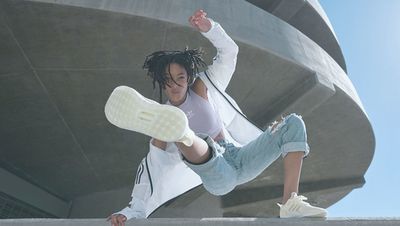Have you ever wondered what happens to your worn-out sneakers when you throw them away? They will likely spend the next few decades decomposing in a landfill.
"You simply take it, grind it up and make a new one. But under the surface, it's extremely technical and complex."
According to the most current government statistics, eight million tons of shoes and clothing were sent to landfills in 2015 alone. As the trashed items break down over many years, they produce toxic greenhouse gases like methane and carbon dioxide, contributing to global climate change.
The Lowdown
Sportswear manufacturer adidas was well aware of their industry's harmful environmental impact, so they set out to become part of the solution. A few years ago, they partnered with various companies to gather and reuse plastics from the ocean to make clothes and parts of shoes.
Then they wondered if they could take their vision a step further: Could they end the concept of waste entirely?
This ambition drove them to create a high-performance athletic shoe made with entirely reusable material – the new FutureCraft Loop. It's a shoe you never have to throw out.
"It's something that outwardly appears very simple," said Paul Gaudio, adidas' Global Creative Director. "You simply take it, grind it up and make a new one. I think that's super elegant and easy to understand. But under the surface, it's extremely technical and complex and it is quite literally a science project."
This project began with a group of engineers, material scientists, and designers trying to find a material that could be pliable enough to take the place of 10-12 different components normally used to make a shoe, yet durable enough to provide the support a running shoe requires. The team decided on thermoplastic polyurethane (TPU), a strong and versatile material that can be re-melted and re-molded even after it's solidified. The team worked for close to a decade on research and development.
Adidas FUTURECRAFT.LOOP
The result, Gaudio said, is an athletic shoe that doesn't compromise on quality and also won't pollute the planet. The wearer will likely notice the shoe feels different because it's welded together by heat alone.
"You feel a more direct connection [to the shoe] because you don't have the layers and glue,"he explained.
Next Up
One of the next steps will be for adidas to engage with consumers to find out the best way to get them to return their used shoes for recycling so that they can, so to say, close the loop.
"We're trying to decide what that looks like," Gaudio said. "Is it a take-back program, is it a subscription mode? Do you return it at stores? So that's the next big challenge that we're working on and that's why we've started to engage people outside the brand in that process."
The FutureCraft Loop is in beta testing with a small group, but if all goes well, the shoe may be available for purchase in early 2021. The pricing hasn't been set, but Gaudio said that the goal is to make it affordable.
"If it's something that's too exclusive or unattainable," he said, "it defeats the purpose."
Open Questions
Although TPU is a completely recyclable material, the team at adidas is working to perfect the process.
"We have a passion to apply creativity and imagination to the problems of plastic in the oceans and the plastic waste."
"Each time you recycle something there is a change – a degradation and contamination," Gaudio noted. "So if I ground the whole thing up, can I make the exact same shoe again with this exact same batch of material today? No, but we can still recycle 100 percent of it. But we're working towards being able to take the knit upper and make a new knit upper."
Gaudio hopes that other companies will follow suit, although adidas is moving to develop ownership of their solutions, including the process behind making the FutureCraft Loop.
"We have a passion to apply creativity and imagination to the problems of plastic in the oceans and the plastic waste and that's what's driving us," he said.
